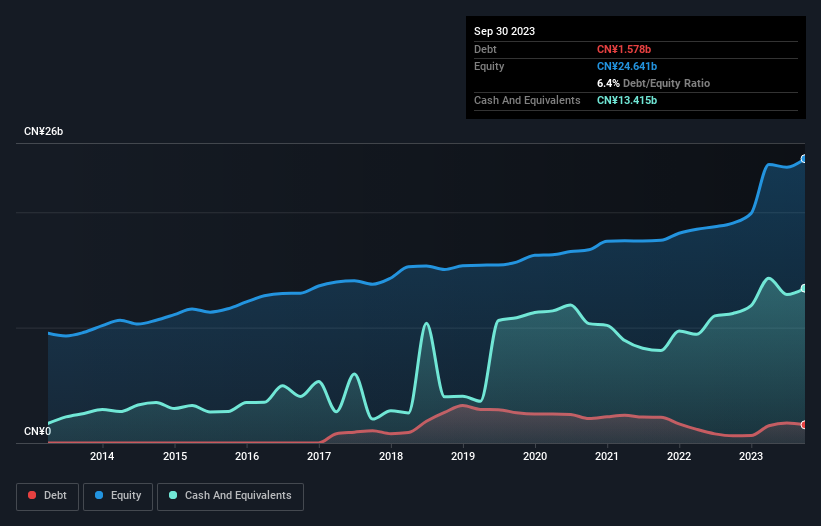The external fund manager backed by Berkshire Hathaway's Charlie Munger, Li Lu, makes no bones about it when he says 'The biggest investment risk is not the volatility of prices, but whether you will suffer a permanent loss of capital.' When we think about how risky a company is, we always like to look at its use of debt, since debt overload can lead to ruin. We can see that Hisense Visual Technology Co., Ltd. (SHSE:600060) does use debt in its business. But should shareholders be worried about its use of debt?
Why Does Debt Bring Risk?
Generally speaking, debt only becomes a real problem when a company can't easily pay it off, either by raising capital or with its own cash flow. Ultimately, if the company can't fulfill its legal obligations to repay debt, shareholders could walk away with nothing. However, a more frequent (but still costly) occurrence is where a company must issue shares at bargain-basement prices, permanently diluting shareholders, just to shore up its balance sheet. Of course, the upside of debt is that it often represents cheap capital, especially when it replaces dilution in a company with the ability to reinvest at high rates of return. The first step when considering a company's debt levels is to consider its cash and debt together.
Check out our latest analysis for Hisense Visual Technology
What Is Hisense Visual Technology's Net Debt?
The image below, which you can click on for greater detail, shows that at September 2023 Hisense Visual Technology had debt of CN¥1.58b, up from CN¥625.8m in one year. But on the other hand it also has CN¥13.4b in cash, leading to a CN¥11.8b net cash position.

How Healthy Is Hisense Visual Technology's Balance Sheet?
The latest balance sheet data shows that Hisense Visual Technology had liabilities of CN¥16.6b due within a year, and liabilities of CN¥1.56b falling due after that. On the other hand, it had cash of CN¥13.4b and CN¥13.8b worth of receivables due within a year. So it actually has CN¥9.11b more liquid assets than total liabilities.
This surplus suggests that Hisense Visual Technology is using debt in a way that is appears to be both safe and conservative. Given it has easily adequate short term liquidity, we don't think it will have any issues with its lenders. Succinctly put, Hisense Visual Technology boasts net cash, so it's fair to say it does not have a heavy debt load!
In addition to that, we're happy to report that Hisense Visual Technology has boosted its EBIT by 31%, thus reducing the spectre of future debt repayments. When analysing debt levels, the balance sheet is the obvious place to start. But it is future earnings, more than anything, that will determine Hisense Visual Technology's ability to maintain a healthy balance sheet going forward. So if you want to see what the professionals think, you might find this free report on analyst profit forecasts to be interesting.
But our final consideration is also important, because a company cannot pay debt with paper profits; it needs cold hard cash. Hisense Visual Technology may have net cash on the balance sheet, but it is still interesting to look at how well the business converts its earnings before interest and tax (EBIT) to free cash flow, because that will influence both its need for, and its capacity to manage debt. Over the last three years, Hisense Visual Technology actually produced more free cash flow than EBIT. That sort of strong cash conversion gets us as excited as the crowd when the beat drops at a Daft Punk concert.
Summing Up
While we empathize with investors who find debt concerning, you should keep in mind that Hisense Visual Technology has net cash of CN¥11.8b, as well as more liquid assets than liabilities. The cherry on top was that in converted 135% of that EBIT to free cash flow, bringing in CN¥3.1b. The bottom line is that we do not find Hisense Visual Technology's debt levels at all concerning. When analysing debt levels, the balance sheet is the obvious place to start. However, not all investment risk resides within the balance sheet - far from it. We've identified 1 warning sign with Hisense Visual Technology , and understanding them should be part of your investment process.
When all is said and done, sometimes its easier to focus on companies that don't even need debt. Readers can access a list of growth stocks with zero net debt 100% free, right now.
Valuation is complex, but we're here to simplify it.
Discover if Hisense Visual Technology might be undervalued or overvalued with our detailed analysis, featuring fair value estimates, potential risks, dividends, insider trades, and its financial condition.
Access Free AnalysisHave feedback on this article? Concerned about the content? Get in touch with us directly. Alternatively, email editorial-team (at) simplywallst.com.
This article by Simply Wall St is general in nature. We provide commentary based on historical data and analyst forecasts only using an unbiased methodology and our articles are not intended to be financial advice. It does not constitute a recommendation to buy or sell any stock, and does not take account of your objectives, or your financial situation. We aim to bring you long-term focused analysis driven by fundamental data. Note that our analysis may not factor in the latest price-sensitive company announcements or qualitative material. Simply Wall St has no position in any stocks mentioned.
About SHSE:600060
Hisense Visual Technology
Engages in the research and development, production, and sales of display chips and products in China and internationally.
Flawless balance sheet, undervalued and pays a dividend.
Similar Companies
Market Insights
Community Narratives




